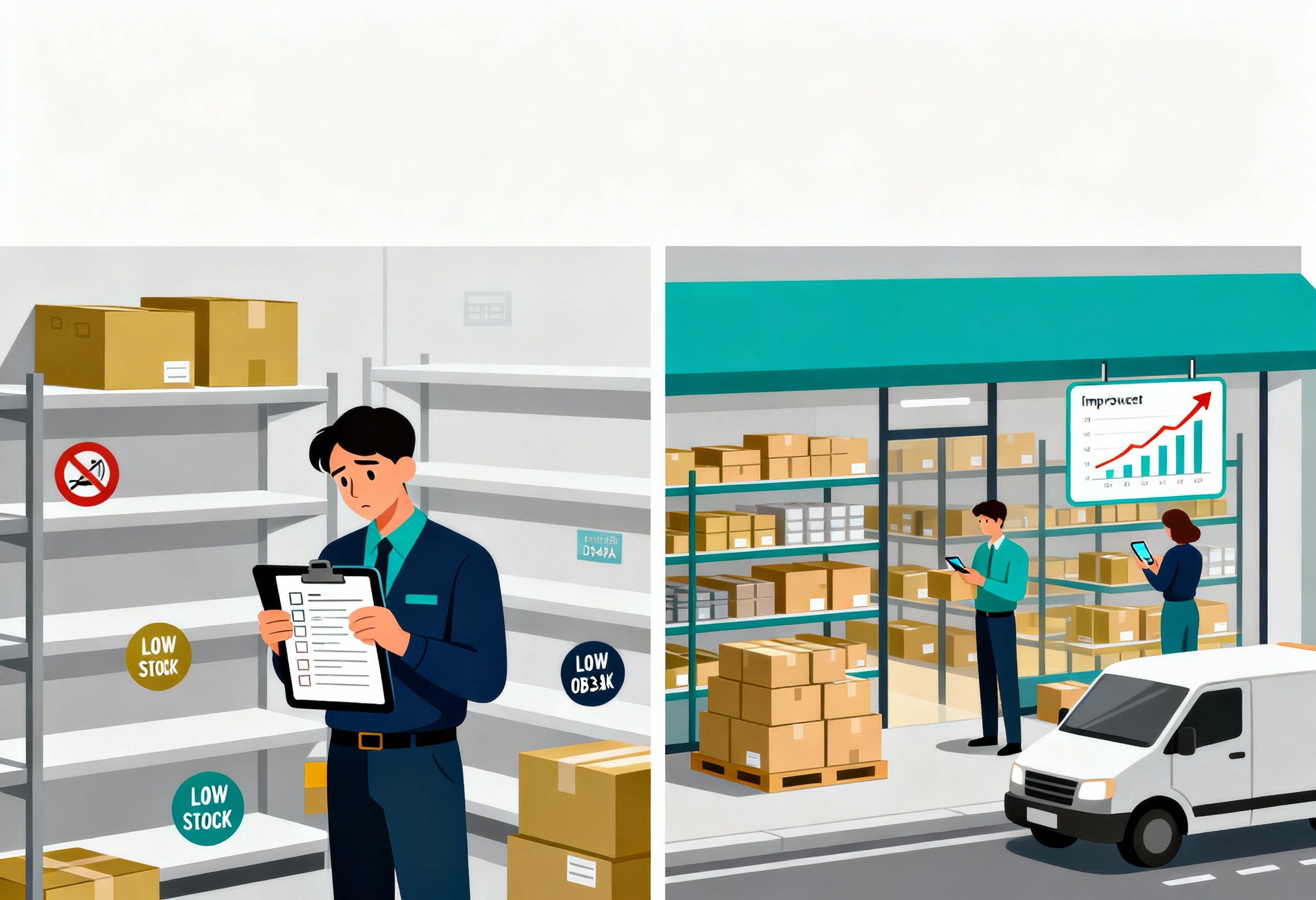Running out of stock is one of the most frustrating challenges for both businesses and customers. When products are unavailable, it can lead to missed sales opportunities, damaged customer trust, and long-term brand impact. Preventing out of stock products requires more than simply keeping shelves full, yet it involves accurate forecasting, efficient inventory management, and streamlined supply chain processes.
This blog will explore practical strategies to reduce the risk of products going out of stock and provide insights to help businesses stay prepared. By applying these methods from ConnectPOS, companies can improve customer satisfaction and maintain steady growth without unnecessary disruptions.
Keep reading!
Highlights
- Stockouts often result from poor forecasting, supply chain issues, or inefficient inventory management, but proactive strategies can minimize risks.
- Key solutions include automating inventory tracking, maintaining safety stock, strengthening supplier relationships, and streamlining omnichannel synchronization.
- Advanced technology with features like real-time updates, automated alerts, advanced reporting, and BackOrder helps businesses prevent stockouts and keep sales flowing.
Why Do Stockouts Happen?
Stockouts often occur due to a combination of forecasting errors, operational gaps, and unpredictable market shifts. Common reasons include:
- Poor demand forecasting – Businesses may underestimate or overestimate customer demand, leading to imbalanced stock levels. Seasonal changes and trend-driven spikes add more complexity, making accurate forecasting difficult.
- Supply chain disruptions – Delays from suppliers, transportation issues, or global shortages can interrupt the flow of goods. Even a minor delay at one stage can cascade into empty shelves or late deliveries.
- Inefficient inventory management – A lack of real-time stock visibility across sales channels often causes businesses to oversell or understock. Manual errors in tracking and reordering also increase the risk of stockouts.
- Unexpected sales surges – Sudden demand during holiday shopping, promotional events, or viral product popularity can quickly deplete inventory. Without proper planning, businesses struggle to restock in time.
Understanding these causes helps retailers pinpoint weak areas and build strategies that keep products available for customers.
What are the Impacts of Running Out of Stock Products on Your Businesses?
Out of stock products affect more than just immediate sales. They create long-term challenges that can harm profitability and customer relationships. Key impacts include:
- Lost sales opportunities – When products are unavailable, customers often turn to competitors. This leads to missed revenue and potential long-term market share loss.
- Negative customer experience – Shoppers expect reliability. Repeated stockouts can frustrate customers, reduce trust, and damage brand reputation. Over time, this lowers customer loyalty and retention.
- Increased operational costs – Emergency restocking, expedited shipping, or last-minute supplier arrangements often come at a higher cost. These unplanned expenses reduce overall margins.
Addressing stockout risks is essential to protect revenue, maintain customer satisfaction, and keep costs under control. Businesses that take proactive steps to prevent shortages are better positioned to build stronger customer relationships and achieve consistent growth.
Consider Key Strategies to Prevent Out Of Stock Products
Preventing stockouts requires more than quick fixes – it takes a proactive and well-structured approach.
Improve Demand Forecasting
Accurate demand forecasting is one of the most effective ways to prevent stockouts. By understanding customer buying patterns, businesses can make informed decisions about inventory levels. Key steps include:
- Leverage historical sales data – Past sales provide valuable insights into product performance. Tracking patterns helps predict future demand more accurately.
- Apply predictive analytics – Advanced tools can analyze market trends, customer behavior, and external factors to improve forecast accuracy.
- Plan for seasonal spikes and promotions – Demand often rises during holidays, special events, or sales campaigns. Factoring these into forecasts ensures stock levels meet customer needs.
With stronger forecasting, businesses can reduce uncertainty, keep shelves stocked, and avoid missed sales opportunities.
►►► Optimal solution set for businesses: Multi store POS, Next-gen POS, Inventory Management Software (MSI), Self Service, Automation, Backorders
Automate Inventory Management
Automating inventory management helps businesses minimize errors and improve efficiency. Manual tracking often leads to mistakes or delays, but automation ensures greater accuracy and control. Key practices include:
- Adopt POS systems with real-time stock tracking – Real-time data allows businesses to see inventory levels instantly across all channels. This visibility reduces the chance of overselling or running out of stock.
- Set up automatic low-stock alerts and reorder points – Automated alerts notify staff when stock reaches a set threshold. Reorder points can trigger purchase orders automatically, preventing gaps in supply.
With automation in place, businesses can save time, cut operational risks, and keep products available to meet customer demand.
Strengthen Supplier Relationships
Strong supplier relationships are essential to maintaining a steady flow of products and preventing stockouts. Building trust and creating flexible arrangements can help businesses respond quickly to unexpected changes. Key actions include:
- Diversify suppliers for backup options – Relying on a single supplier increases risk. Having multiple partners ensures alternative sources if delays or shortages occur.
- Negotiate flexible supply agreements – Agreements that allow for adjustments in order quantities, delivery times, or payment terms give businesses more stability and adaptability during demand shifts.
By strengthening supplier relationships, businesses can secure more reliable supply chains and reduce the likelihood of inventory disruptions.
Implement Safety Stock Policies
Safety stock acts as a buffer against uncertainty in demand and supply. By keeping extra inventory on hand, businesses can continue serving customers even during unexpected disruptions. Key steps to prevent out of stock products:
- Maintain buffer stock for high-demand products – Essential or fast-moving items should always have a safety reserve to prevent sudden shortages.
- Balance carrying costs with customer needs – Holding too much stock increases storage expenses, but too little can lead to missed sales. Finding the right balance ensures both efficiency and customer satisfaction.
With well-planned safety stock policies, businesses can reduce the risk of stockouts while keeping operations cost-effective.
Streamline Omnichannel Synchronization
Managing inventory across multiple sales channels can be challenging without proper synchronization. When systems are disconnected, the risk of overselling or inaccurate stock levels increases. To prevent this, businesses should:
- Ensure online and offline channels share the same inventory data – A unified system provides a single source of truth, giving accurate visibility of stock across all platforms.
- Prevent overselling by syncing stock in real time – Real-time updates ensure that once an item is sold, it is immediately reflected across every channel, reducing customer frustration and operational errors.
By streamlining omnichannel synchronization, businesses can deliver a smoother shopping experience and maintain better control of their inventory.
Leverage Technology & Integrations
Technology plays a crucial role in preventing stockouts by connecting different parts of the retail operation. When systems work together, businesses gain better visibility and control. Key practices include:
- Integrate POS with ERP, warehouse, and fulfillment solutions – Connecting these systems creates a seamless flow of data, reducing errors and improving decision-making.
- Gain complete visibility from supplier to customer – Integrated platforms allow businesses to track products at every stage, from procurement to final delivery, ensuring accurate inventory management.
By leveraging technology and integrations, businesses can streamline processes, anticipate issues earlier, and maintain reliable product availability.
How ConnectPOS can Resolve Stockouts Situation?
ConnectPOS provides retailers with the tools they need to keep inventory under control and minimize the risk of out of stock products. Its key features include:
- Real-time omnichannel synchronization to keep online and offline sales channels updated instantly.
- Automated low-stock alerts and pre-order/backorder management to reduce missed sales opportunities.
- Advanced analytics and reporting for more accurate forecasting and smarter inventory planning.
- Seamless integration with marketplaces, ERPs, and fulfillment systems for smoother operations.
BackOrder by ConnectPOS adds even more flexibility:
- List and sell unavailable items with just a few simple settings.
- Activate backorders in seconds by defining stock thresholds, shipping options, and restock dates.
- Assign products automatically based on inventory rules or manage them directly in BigCommerce’s product dashboard.
- Personalize product detail pages with backorder buttons, shipping notices, cart alerts, or stock status labels.
With ConnectPOS, businesses can maintain product availability and keep customers satisfied.
In Conclusion
Out of stock products can disrupt sales, frustrate customers, and raise operational costs, but they are preventable with the right strategies and tools. By improving demand forecasting, automating inventory management, strengthening supplier relationships, and leveraging technology, businesses can reduce risks and keep products available. ConnectPOS takes this further with real-time synchronization, automated alerts, advanced analytics, and seamless integrations that help retailers stay ahead of shortages. With BackOrder, even out-of-stock products can remain sellable, ensuring no sales opportunities are missed.
Ready to prevent stockouts and deliver a better shopping experience? Contact ConnectPOS today to discover how its solutions can keep your business stocked and your customers satisfied.
FAQs: Out of Stock Products
How can I calculate the right safety stock level for my business?
Safety stock is usually calculated based on average demand, lead time, and demand variability. A common formula is: Safety Stock = (Maximum Daily Usage × Maximum Lead Time) – (Average Daily Usage × Average Lead Time). Businesses can also use inventory management software that automatically adjusts safety stock levels based on real-time data.
Is it better to hold more inventory to prevent stockouts?
Holding extra stock can reduce the risk of shortages, but it also increases carrying costs such as storage, insurance, and potential waste. The best approach is to strike a balance – maintain safety stock for fast-moving items and use accurate forecasting to avoid overstocking.
What tools can help track and forecast inventory more accurately?
POS systems, ERP platforms, and demand forecasting software provide real-time stock tracking and predictive insights. Tools like ConnectPOS offer automated low-stock alerts, analytics, and integrations to help businesses plan more effectively.
How do out-of-stock products affect customer loyalty in the long run?
Repeated stockouts can frustrate customers, erode trust, and push them toward competitors. Over time, this reduces customer loyalty and retention. Consistently meeting product demand, on the other hand, builds reliability and strengthens long-term relationships.
►►► Optimal solution set for businesses: Shopify POS, Magento POS, BigCommerce POS, WooCommerce POS, NetSuite POS, E-Commerce POS



